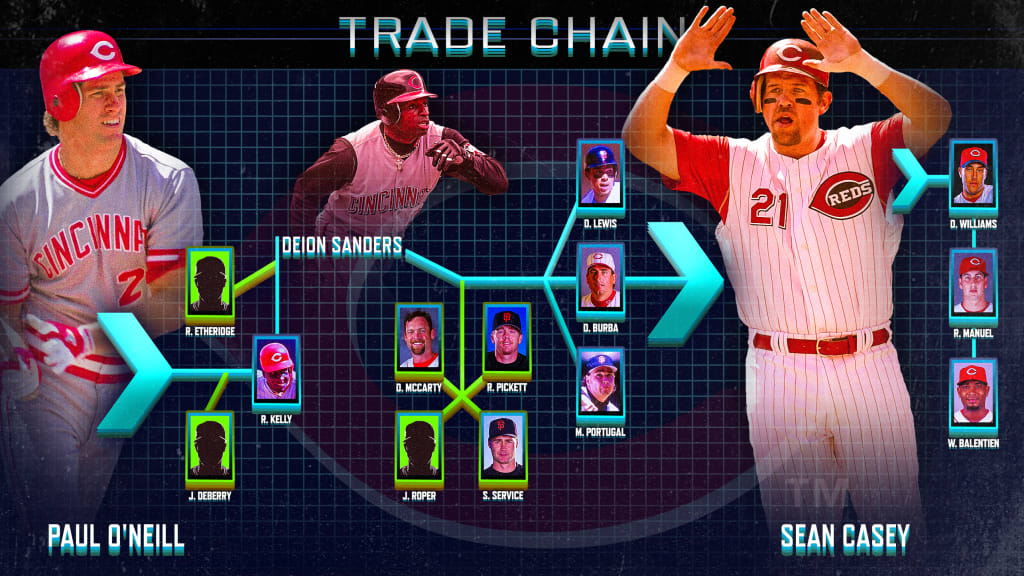
CINCINNATI -- Paul O'Neill, Deion Sanders and Sean Casey have more in common than being popular former Reds stars. First, they all happened to wear the same uniform number -- 21.
But there is another more interesting connection. All three players are linked via a lengthy trade tree of transactions that spanned nearly three decades.
Here’s how it all happened:
June 8, 1981: Reds select O’Neill in the fourth round of the MLB Draft
A native of Columbus, Ohio, O’Neill grew up a Reds fan during the Big Red Machine era. He signed with Cincinnati three days after his selection, debuted in the big leagues during the 1985 season and became the regular right fielder by '88. Known for his intensity on the field, in '89 O’Neill once kicked a baseball to the infield after misplaying it to save a run. And a key member of the '90 World Series-winning club, he made his first All-Star Game the following season.
Nov. 3, 1992: Reds trade O’Neill and Minor League first baseman Joe DeBerry to the Yankees for Roberto Kelly
In 1991, O’Neill slugged a career-high 28 home runs alongside a 4.9 bWAR, but his numbers dipped in ’92. At first, the trade looked like a good move for the Reds. Kelly was an All-Star center fielder and a rising Yankees star; O’Neill was not the power hitter manager Lou Piniella envisioned. It ultimately didn’t prove successful for Cincinnati, however. O’Neill blossomed in New York and became a cornerstone for four World Series titles while hitting .303/.377/.492 over nine seasons.
Kelly lasted only one-plus season with the Reds, although he was an All-Star in 1993 while batting .319/.354/.475 with nine homers. But he was limited to 78 games because a shoulder injury knocked him out for the second half.
May 29, 1994: Reds trade Kelly and Minor League pitcher Roger Etheridge to the Braves for Sanders
“Neon Deion” was already a sensational cornerback in the NFL, but he had elevated to a two-sport star as an outfielder with the Yankees and Braves. Following the trade, he brought his speed to Cincinnati as he stole 19 of his 38 total bases that season for his new team while batting .277/.342/.359. This was the first of three Reds stints for Sanders, as he returned in 1997 and 2001. Over four seasons, he played 226 games for the club.
July 21, 1995: Reds trade Sanders, Dave McCarty, Ricky Pickett and Scott Service to the Giants for Dave Burba, Mark Portugal and Darren Lewis
The Reds had the best record in the NL but were weak on starting pitching, especially after a right elbow injury to ace Jose Rijo. Portugal -- who also wore No. 21 for Cincinnati -- would go 14-14 with a 3.93 ERA in 41 games (40 starts) with the Reds. Lewis, an outfielder, was released after the 1995 season. But Burba, who hailed from nearby Springfield, Ohio, spent three seasons with the Reds and was 28-25 with a 4.09 ERA in 79 games (69 starts).
March 30, 1998: Reds trade Burba to the Indians for Casey
This deal was a stunner because of its timing. Burba was less than 24 hours away from being Cincinnati’s Opening Day starter when he was moved to Cleveland as general manager Jim Bowden slashed payroll. Casey was a 23-year-old top prospect for Cleveland and had a rough start to his tenure with the Reds.
Four days after the trade, Casey was struck in the eye by a thrown ball during batting practice and suffered a fractured orbital bone that required surgery. He returned a month later and was batting .150 when he was optioned to Triple-A. By 1999, things turned around. Casey went to the first of his three All-Star Games as he batted .332/.399/.539 with 25 homers, 99 RBIs and a 4.0 WAR by year's end. Over eight seasons with the Reds, he batted .305/.371/.463 with 118 homers.
Casey’s infectiously upbeat personality and affability made him one of the club’s most popular players in its long history. He was nicknamed “The Mayor” because of his ability to get along with anybody in the clubhouse as well as the fans, plus for his charitable efforts. The Reds inducted him into their Hall of Fame in 2012.
Dec. 8, 2005: Reds trade Casey and cash to the Pirates for Dave Williams
As one of GM Dan O’Brien’s final moves before he was replaced by new ownership the following month, this trade had two motivations. It was a salary dump of much of Casey’s $8.5 million contract but also part of an ill-fated plan to move star left fielder Adam Dunn to first base so Wily Mo Peña could play left. New GM Wayne Krivsky scuttled that plan when he took over in February by dealing Peña to the Red Sox for Bronson Arroyo and having Dunn return to his spot in left. Krivsky signed Scott Hatteberg to replace Casey instead.
Williams, a left-handed starter, was put into an already questionable rotation and had disastrous results as he was 2-3 with a 7.20 ERA in eight starts. He allowed nine homers in only 40 innings, and his stay in Cincinnati was short.
May 25, 2006: Reds trade Williams to the Mets for Robert Manuel
A right-handed reliever, Manuel spent three seasons in the Reds' Minor League system before his big league debut in 2009. He made three appearances with 4 1/3 scoreless innings before being sent back to Triple-A.
July 29, 2009: Reds trade Manuel to the Mariners for Wladimir Balentien
A right-handed-slugging outfielder from Curacao, Balentien batted .264/.352/.427 with three homers in 40 games with the Reds. But he didn’t get another chance in the Major Leagues. While he hit 25 homers for Triple-A Louisville in 2010, Cincinnati didn’t call upon him as it won the NL Central.
So ends this lengthy trade tree 29 years after O’Neill’s Draft selection. In 2011, Balentien took his talents to Japan and has spent the past nine seasons with the Yakult Swallows before joining the Fukuoka Softbank Hawks for '20. In '13, he broke a long-held Japanese record with 60 homers in a 130-game season.
